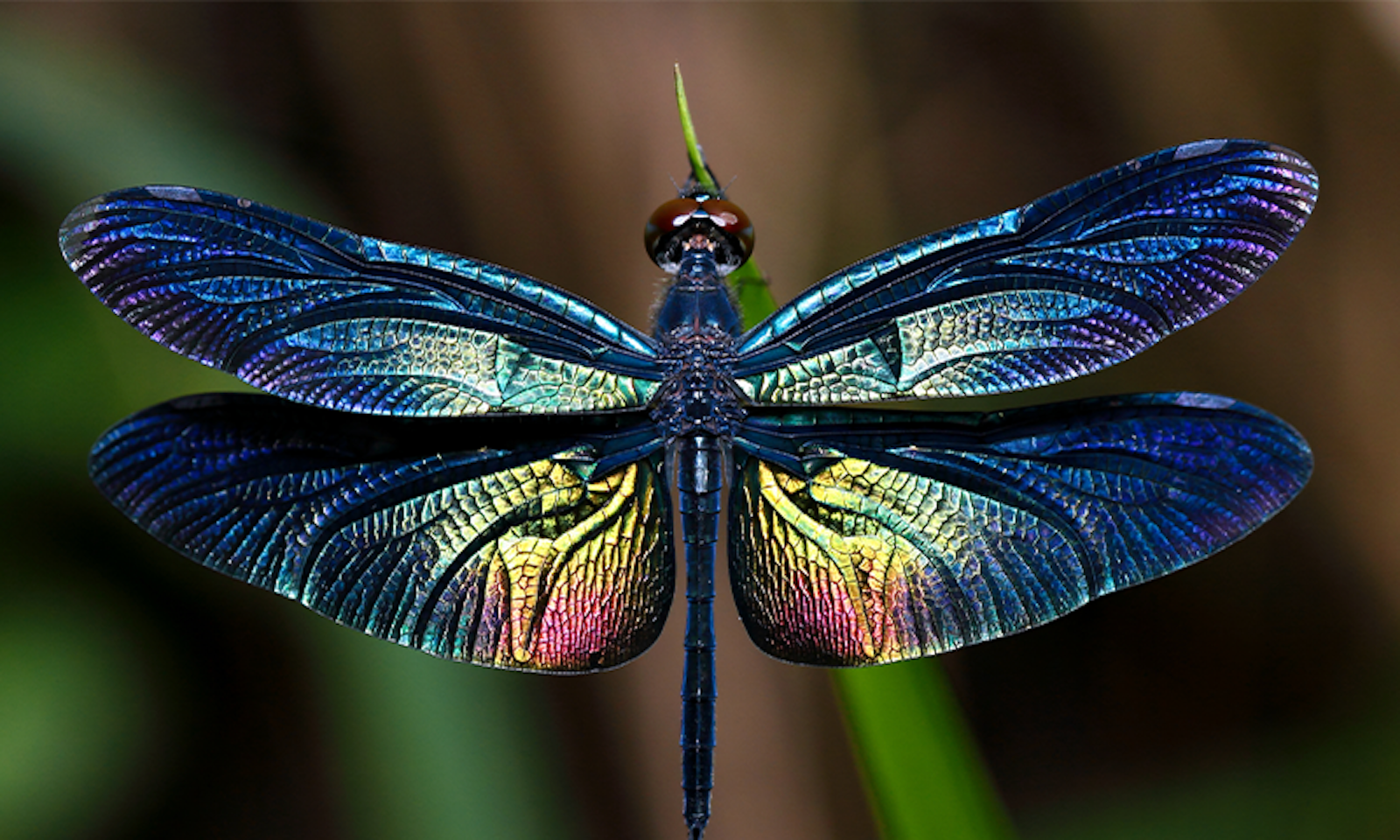Consider the dragonfly, zigging and zagging over a lake in summer like a runaway rainbow, seeming to defy gravity and logic. How can such delicate wings carry aloft that long body at such great velocities? With its shimmery complexion and high-speed flight, it seems almost possessed of magic. No wonder dragonfly folklore and mysticism abound. In Japanese literature and art, the dragonfly is an important symbol of victory in battle. In the Middle Ages, Europeans associated it with diabolic spirits. In some Native American cultures, dragonflies represent purity, swiftness, transformation, and invincibility.
In reality, dragonflies do have unique powers of flight. Unlike most other insects, they possess two pairs of wings that flap independently. They can turn up to 180 degrees in two or three wing beats and generate aerodynamic force—a combination of lift, weight, thrust, and drag—equal to over four times their own body weight (which ranges between 600 milligrams and 1 gram). They can hover and glide. They are so adept at flying that, in the past couple of years, some researchers have begun studying them to help design tiny aircraft that can monitor hazardous environments remotely. These micro air vehicles, as researchers call them, can be as small as 5 centimeters, but might in the future be even tinier—insect-sized.

Though dragonflies live only very briefly—on average just a week or two, up to a maximum of eight—they really get around. They crisscross the globe in search of breeding and foraging grounds, and some species can travel at up to 30 miles an hour. In the process, dragonflies connect distant ecosystems and food webs—like other migrating insects. Researchers have begun trying to trace their migratory routes to better understand the impact they have on food cycles, the distribution of nutrients, pollination, and the spread of disease-causing micro-organisms.
Tiny temperature shifts may be making dragonflies’ global peregrinations more difficult, and in the process, disrupting their cycle of life. Dragonfly populations have been declining and some researchers believe the increasing arduousness of their migratory trips may be at fault. If dragonflies stop making these trips, they could quietly shake up global ecology.
One study from earlier this year identified the specific migration route of a dragonfly species called Pantala favescens, considered the most widespread dragonfly on the planet. That route spans 14,000 to 18,000 kilometers from India to Africa without stopovers.
Dragonflies can turn up to 180 degrees in two or three wing beats.
On this particular route, the dragonfly gets some assistance from the Somali Jet Stream, a tropical wind stream, and the researchers found it actively compensates for wind in the planning of its migration route. Migrating dragonflies travel in swarms—sometimes rivaling those of locusts in density—which researchers think may help reduce the aerodynamic drag on each individual. Still, because wind conditions change, the timing of the journey is the key to a successful migration. The first leg of the trip, from India to Africa, is thought to take a maximum of 90 hours at velocities of around 10 miles per hour. On the way back, when it can’t take advantage of the wind, the dragonfly takes breaks at a pair of islands, the Maldives and Seychelles, that are disappearing as sea levels rise. If the ocean claims the islands, that could sink future dragonfly migrations along this route.
In another study, researchers attached miniature radio transmitters to the thoraxes of 12 individual dragonflies to track their migration patterns. In the Northern Hemisphere, northward dragonfly migrations seem to peak in spring and southward migrations in autumn, with the largest swarms tracing the borders of lakes, seashores, cliffs, or ridges, including the coasts of Florida, the shores of the Great Lakes, the Oregon and California coast, the Atlantic coast, and Delaware Bay at Cape May, NJ.
The researchers found these dragonfly patterns—distinct migration seasons and dependence on weather—mirror songbird migration behavior. Like songbirds and other insects, dragonflies also prepare for migration by accumulating stores of fat. The scientists propose that a simple set of rules may apply to all creatures who migrate through the air over long distances at high speeds.
The dragonfly is a singular creature, but it shares kinship with other winged things. Like the dragonfly of myth, at once a symbol of both darkness and light, this tiny insect is engaged in its own battle against the forces of change. ![]()
Lead image by AgriTech / Shutterstock




























